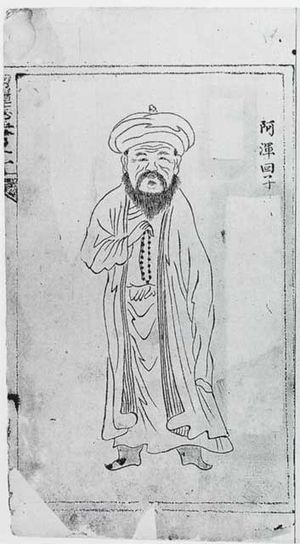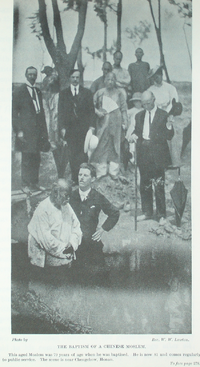الإسلام في عهد أسرة تشينگ
| جزء من سلسلة عن الإسلام في الصين |
|---|
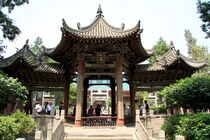 |
|
|
Qing dynasty (1644–1911). The Qing rulers were Manchu, not Han, and were themselves a minority in China. The Qing dynasty witnessed five Muslim rebellions. The first and last rebellions were caused by sectarian infighting between rival Sufi Muslim orders.
. . . . . . . . . . . . . . . . . . . . . . . . . . . . . . . . . . . . . . . . . . . . . . . . . . . . . . . . . . . . . . . . . . . . . . . . . . . . . . . . . . . . . . . . . . . . . . . . . . . . . . . . . . . . . . . . . . . . . . . . . . . . . . . . . . . . . . . . . . . . . . . . . . . . . . . . . . . . . . . . . . . . . . . .
التمردات على أسرة تشينگ
Ming loyalist Muslims
تمرد پانثاي
ثورة الدونگان
The Dungan revolt by the Hui from the provinces of Shaanxi, Gansu, Ningxia and Xinjiang, broke out due to a pricing dispute over bamboo poles which a Han merchant was selling to a Hui. It lasted from 1862 to 1877. The failure of the revolt led to the flight of many Dungan people into Imperial Russia.
التمردات
During the mid-nineteenth century, the Muslims revolted against the Qing dynasty, most notably in the Dungan revolt (1862–1877) and the Panthay rebellion 1856–1873) in Yunnan. One million people died in the Panthay rebellion,[1][2] and several million died in the Dungan revolt[2][2]
الثقافة
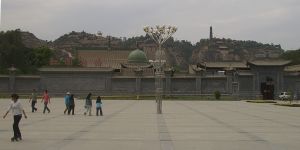
In the Qing dynasty, Muslims had many mosques in the large cities, with particularly important ones in Beijing, Xi'an, Hangzhou, Guangzhou, and other places (in addition to those in the western Muslim regions). The architecture typically employed traditional Chinese styles, with Arabic-language inscriptions being the chief distinguishing feature. Many Muslims held government positions, including positions of importance, particularly in the army.
The origin of Hui in Ürümqi is often indicated by the names of their Mosques.[3]
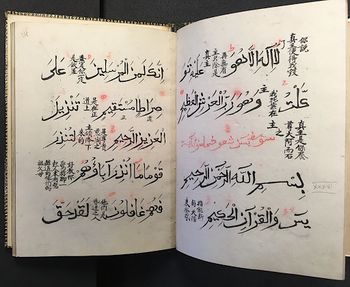
الهجرات
The Chin Haw are a group of Chinese immigrants who arrived in Thailand via Burma or Laos. Most of them were from Yunnan and about a third were Muslim.
في القرن التاسع عشر، Chinese Muslims also became some of the first Muslims in New Zealand (انظر الإسلام في نيوزيلندا). They came as golddiggers to work in the Dunstan gold fields in Otago in 1868.[4]
أنشطة المبشرين المسيحيين
As the presence of Christian missionaries of various sects increased in China after the Opium Wars, they became interested in converting China's Muslims to Christianity. A significant amount of research was dedicated to the Muslim "problem", as Marshall Broomhall called it, but the effort resulted in no large-scale conversions.
Under the "fundamental laws" of China, one section is titled "Wizards, Witches, and all Superstitions, prohibited." The Jiaqing Emperor in 1814 A.D. added a sixth clause in this section with reference to Christianity. It was modified in 1821 and printed in 1826 by the Daoguang Emperor. It sentenced Europeans to death for spreading Christianity among Han Chinese and Manchus (tartars). Christians who would not repent their conversion were sent to Muslim cities in Xinjiang, to be given as slaves to Muslim leaders and beys.[5]
See also
- Islam during the Tang dynasty
- Islam during the Song dynasty
- Islam during the Yuan dynasty
- Islam during the Ming dynasty
- Religion in China
- Demographics of the People's Republic of China
الهامش
- ^ خطأ استشهاد: وسم
<ref>غير صحيح؛ لا نص تم توفيره للمراجع المسماةLonely Planet - ^ أ ب ت Gernet, Jacques. A History of Chinese Civilization. 2. New York: Cambridge University Press, 1996.ISBN 0521497124
- ^ Millward, James A. (1998). Beyond the Pass: Economy, Ethnicity, and Empire in Qing Central Asia, 1759-1864 (illustrated ed.). Stanford University Press. p. 169. ISBN 978-0804729338. Retrieved 24 April 2014.
{{cite book}}: Invalid|ref=harv(help) - ^ Muslim Community in New Zealand
- ^ Robert Samuel Maclay (1861). Life among the Chinese: with characteristic sketches and incidents of missionary operations and prospects in China. Carlton & Porter. p. 336. Retrieved 2011-07-06.
المراجع
- Forbes, Andrew ; Henley, David (2011). Traders of the Golden Triangle (chapter on Du Wenxiu, the Panthay Rebellion and the founding of Panglong in Burma). Chiang Mai: Cognoscenti Books. ASIN: B006GMID5K
- Kim Hodong, "Holy War in China: The Muslim Rebellion and State in Chinese Central Asia, 1864-1877". Stanford University Press (March 2004). ISBN 0-8047-4884-5.
- Keim, Jean (1954). Les Musulmans Chinois. France Asie.
- Gernet, Jacques. A History of Chinese Civilization. 2. New York: Cambridge University Press, 1996. ISBN 0-521-49712-4
- Ring, Trudy; Salkin, Robert M.; La Boda, Sharon, eds. (1996). International Dictionary of Historic Places: Asia and Oceania. Vol. Volume 5 of International Dictionary of Historic Places (illustrated, annotated ed.). Taylor & Francis. ISBN 978-1884964046. Retrieved 24 April 2014.
{{cite book}}:|volume=has extra text (help); Invalid|ref=harv(help)

